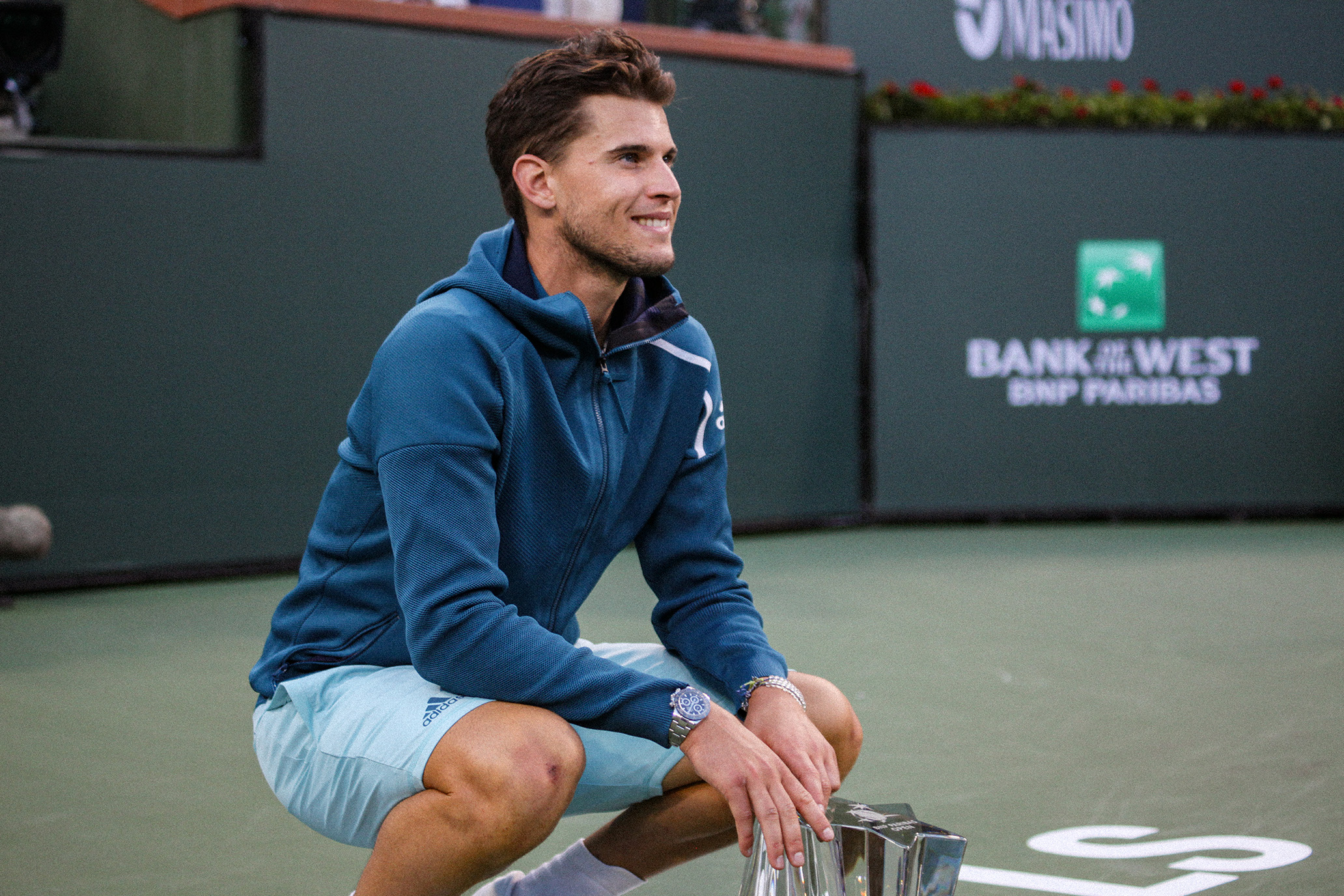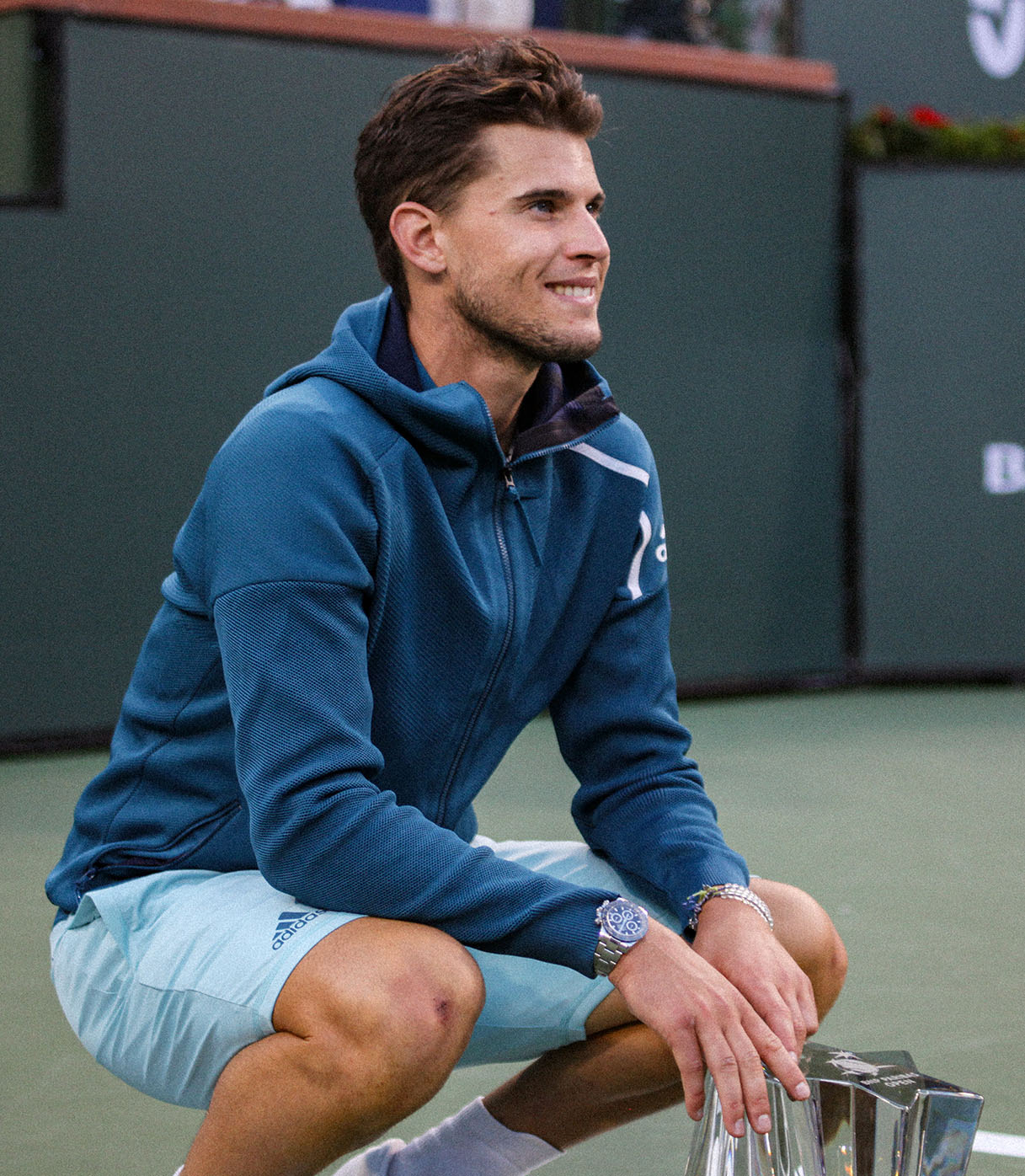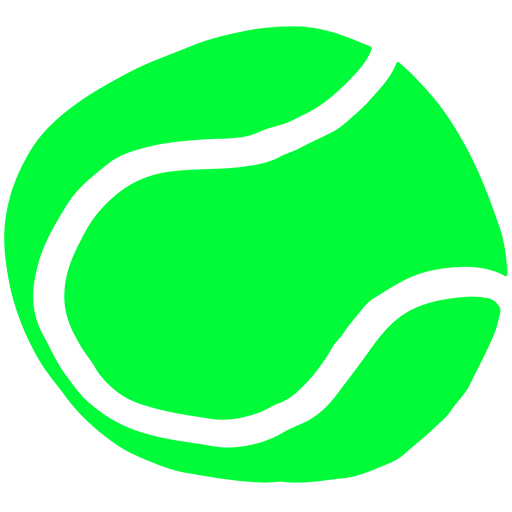Exit a Minor Titan
Exit a Minor Titan
Dominic Thiem was a worthy foil for the Big Three–for a while, at least.
Dominic Thiem was a worthy foil for the Big Three–for a while, at least.
By Giri NathanOctober 25, 2024

Dominic Thiem after defeating Roger Federer in the 2019 Indian Wells final. // David Bartholow

Dominic Thiem after defeating Roger Federer in the 2019 Indian Wells final. // David Bartholow
Sometimes time corrects false impressions. This was certainly my experience with Dominic Thiem, who retired this week at the young age of 31, having lost his best tennis well before. Now I worry that his body of work, though decently impressive on paper, might not do justice to his beastly talent. Seven years ago, when I first started writing about this sport, I didn’t really believe in that talent at all.
In summer 2017 I was at the Citi Open Washington D.C., reporting a piece on the future of the men’s tour. I left that tournament with a dim impression of Dominic Thiem: a hapless ball-basher who played too busy a tour schedule and never adjusted his tactics to succeed off of clay courts. This was just a few weeks after a hungover Roger Federer, the morning after winning Wimbledon, had expressed his horror at a younger generation with no net skills to finish points quickly. Perhaps no young player seemed more remote from the net than Thiem, who was then notorious for camping out miles behind the baseline to set up his big ground strokes. I asked Thiem what he thought about Federer’s advice. “Everybody likes to see something different, but nobody is going to change the style of game,” he said, clearly never going to leave his happy place at the back wall of the court. Another example of how inflexible and hardheaded he was, I thought—he’d never make it!
Thiem seemed to me a placeholder, a player of temporary interest until the next true generational player arrived to usher Federer, Rafael Nadal, and Novak Djokovic out of the game. Surely that guy was coming soon. Here he comes. This is the one…or maybe that is the one. But it’ll be any minute now. Right? Year after year passed, prospect after prospect faded, and the Big Three continued to reign. In time I came to grasp just how anomalous those three were, how superior they were to so many successive generations of players, how many potential breakthroughs they managed to quash. And while I came to this realization, the man I’d once dismissed, that stubborn and sedulous ball-basher, kept toiling away. And improving. His blind power got smarter. He found better angles instead of whaling away down the middle. He stepped up into the court when he needed to play a little faster. He expanded his success out from clay to hard courts. He was becoming, if not quite their equal, a constant irritant.
If you consider the 2017–2020 seasons as the final phase of the Big Three era—the last time all three were pretty healthy, clogging up the draw at every big event, winning all the Slams—it’s clear who their worthiest competitor was in that span. It wasn’t Andy Murray, who spent those years ravaged by injury and spiraling toward his first retirement. It was in fact Thiem, who could often hit a peak level defined by overwhelming power and spin, the biggest one-handed backhand since Stan Wawrinka, and a bruising physicality. All that was enough to amass a 16–19 record against the best players ever: 5–2 against Federer, 6–10 against Nadal, 5–7 against Djokovic. Dominic Thiem isn’t as good as Andy Murray, but he is the only player to match the rare feat of having beaten all members of the Big Three at least five times apiece.
Beyond the numbers, I’ll remember the distinctive stamp Thiem put on those matches. His conviction in his own style paid off in the end. Nobody was beating the Big Three with fussy attritional baseline play; it took something bolder and bloodier, a commitment to full power, no second thoughts. And with that burly style of play, Thiem had a knack for epics, for entertaining us in wins and losses alike. His nearly five-hour loss to Nadal in the 2018 US Open quarterfinal is about as close as tennis gets to blood sport. Wins like the one over Federer at Indian Wells in 2019, or the one over Novak Djokovic at the ATP Finals later that year, proved how dangerous he could be when his baseline game was in full flow. “No matter the surface, you always found a way to beat me with your thunderous backhands,” Federer wrote in his tribute to Thiem this week.
Thiem got his lone Slam in 2020, in odd conditions, and faded out almost immediately after. It would take four more seasons before the tour found those long-awaited generational talents, the ones who would finally wrest the game away from that old triad, with Djokovic as their last standing delegate. It was only in 2024 that Jannik Sinner and Carlos Alcaraz took over. And even so, at age 37, playing a part-timer’s schedule and wearing a knee sleeve after a meniscus repair, Djokovic is still good enough to steal away a gold medal and beat pretty much every other player on tour. That’s how hard he is to take down. Having seen how history played out, I’ve come to understand just how unusual it was for Thiem to battle these three guys and come away with an almost 50/50 record. My first impressions were way off. Dominic Thiem wasn’t a lunk, but in fact a minor titan. He didn’t last long, but what he accomplished in his prime was more than the other mortals could manage.


The Hopper
—CLAY Tennis on Beatriz Haddad Maia’s US Open run.
—Giri on Iga Swiatek’s loss to Jess Pegula.
—Jon Wertheim’s mailbag is full this week.
—Sara Errani and Andrea Vavasori have won the US Open mixed doubles.
—Tim Newcomb on Taylor Fritz and Asics.

PURE, ORIGINAL TENNIS — SIGN UP!
RECOMMENDED
Big House Boris
BOOK REVIEWS
New Again: Adidas’s Barricade Gets An Update
SNEAKERS — WILSON


